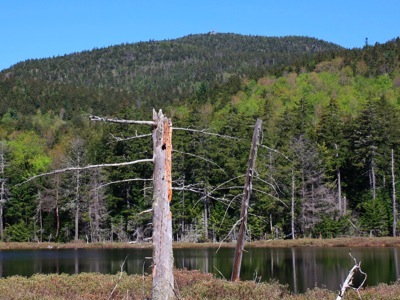May 27, 2012





By Marty Basch
Shingle Pond isn't much, a tiny boggy alpine pond reached by a lackluster, little loved trail in an often-overlooked piece of the White Mountain National Forest.
There is much to dissuade a hiker from going there: mud, slippery mossy rocks, pesky bugs, nasty ticks, blow-downs, no apparent perimeter path, limited views and plenty of opportunity to lose the trail.
There are far better ways to spend a summer-like spring Saturday morning than trekking the roughly 5.4-mile out and back journey along the Weeks Brook Trail in Chatham, near the Maine border.
But there are some wonderful soft underfoot and peaceful hemlock groves to pass through, including a portion that signals the pond is near.
And once at the pond, it's likely there won't be many other hikers about to gaze up to the 3251-foot summit of ledgy Kearsarge North and see a popular White Mountain manmade landmark no doubt swarming with weekend warriors: the Kearsarge North fire tower.
Plus, the trek left me wondering if I plodded on a lost New Hampshire hiking trail.
Be forewarned. Parts of the trail are difficult to follow, even with a map and guide books. I had two guide books with me (Steve Smith's delightfully dog-eared1993 classic “Ponds and Lakes of the White Mountains” and the trusty 28th edition of the “AMC's White Mountain Guide” from 2007) and they tried valiantly to steer me the right way, but some stretches are found only through patience, a virtue this hike will teach.
Jumping off point is the readily found Hardwood Hill Road trailhead off Green Hill Road in Chatham, just north of the intersection with the steep Hurricane Mountain Road. The dirt road parking area leads to the initial welcoming and benign introduction to the hike along Forest Road 317 a route once heralded as an early White Mountain mountain bike route before the evolution of manmade single track, berms, rollers and more.
After traversing a solid bridge over gushing Weeks Brook, the trail soon turns right and in a few steps meanders left into the woods. That's easy to miss as the forest road is most hospitable.
Soon enough, the trail becomes ubiquitously wet and squirrelly with infrequent yellow blazes. Remain diligent as the path does eventually lead to a clearly maybe half-way into the ramble. Here, use even more effort and care to stay on the trail which crosses through a soggy and scrubby area before re-entering the woods on more old logging roads. There is an arrow and a hiking sign by this clearing.
It seemed most of the 1200 foot in elevation came from this point on to the pond where the footing was a bit more level. But the trail skirts the pond and is seeing some erosion. I decided to turn around as the trail veered away from the pond and find a few more places to look up at the historic summit tower on the National Historic Lookout Registry I've visited several times.
Near the pond was a hidden red-blazed trail I had missed earlier and followed it over a wide pond drainage.
The pathway wound closer to trails edge and went downhill by some blow-downs that had been cut. Then in the middle of the trail was a decaying stump with a long tube stuck in it. Protruding from the tube was a thick rake. Instead of continuing, I consulted the map I carried and saw no trail off Weeks Brook. I found no mention of this pathway in either guidebook. Instead of pressing on, I turned around (a pitchfork is a great motivator) and retraced the path back to the Weeks Brook Trail.
Only after getting home did I do an internet search and came across a web site with lost New England trails. I'm wondering if that trail is or was the Shingle Pond Trail. The 1934 “AMC White Mountain Guide” contains such a trail under the auspices of the Chatham Trail Association.
The map from that edition has what appears to be a logging road heading southwest from the pound to Kearsarge Village. Or maybe the red markings were a boundary?
Whether that was the old trail, can't really say.
But what I can say is the hike to Shingle Pond is like going to the gym. Don't really enjoy going, but like having gone.

Marty Basch photo


